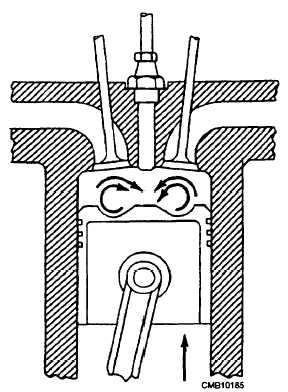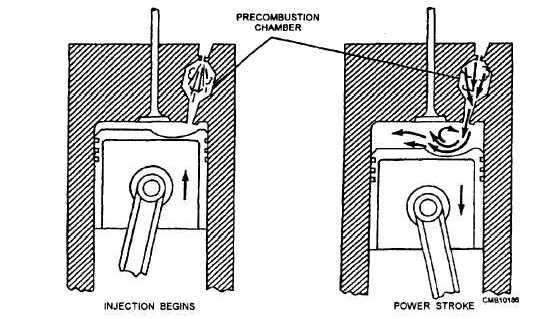
Figure 5-2. - Open combustion chamber.
distributed as evenly as possible throughout the chamber if the engine is to function at maximum efficiency and exhibit maximum drivabilty. A well- designed engine uses a combustion chamber that is designed for the intended usage of the engine. The injects used should compliment the combustion chamber. The combustion chambers described on the following pages are the most common and cover

Figure 5-3. - Precombustion chamber.
virtually all of the designs that are currently in use. These are the open chamber, precombustion chamber, turbulence chamber, and spherical (hypercycle) chamber.
Open Combustion Chamber
The open combustion chamber (fig. 5-2) is the simplest form of chamber. It is suitable for only slow- speed, four-stroke cycle engines, but is widely used in two-stroke cycle diesel engines. In the open chamber, the fuel is injected directly into the space on top of the cylinder. The combustion space, formed by the top of the piston and the cylinder head, usually is shaped to provide s swirling action of the air, as the piston comes up on the compression stroke. There are no special pockets, cells, or passages to aid the mixing of the fuel and air. This type of chamber requires a higher injection pressure and a greater degree of fuel atomization than is required by other combustion chambers to obtain an acceptable level of fuel mixing. To equalize combustion in the combustion chamber, use a multiple orifice-type injector tip for effective penetration. This chamber design is very susceptible to ignition lag.
Precombustion Chamber
The precombustion chamber (fig. 5-3) is an auxiliary chamber at the top of the cylinder. It is connected to the main combustion chamber by a restricted throat or passage. The precombustion chamber conditions the fuel for final combustion in the cylinder. A hollowed-out portion of the piston top
Continue Reading